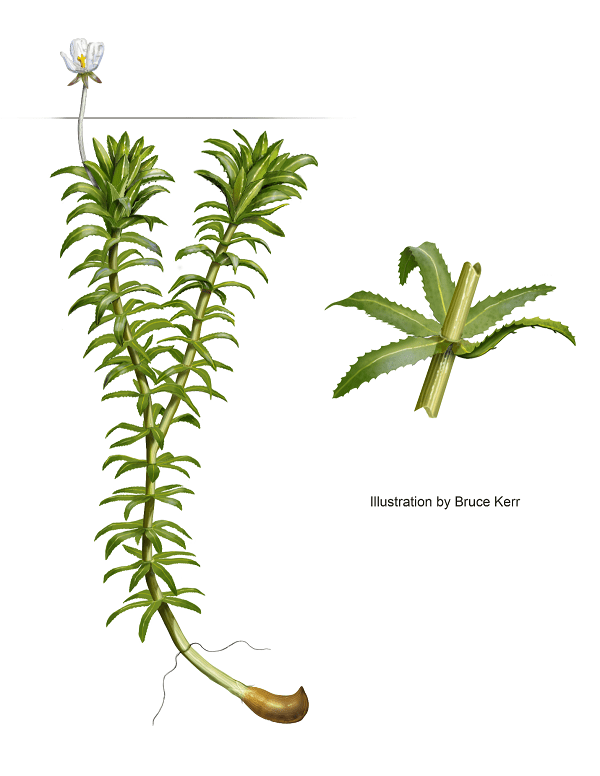The web Browser you are currently using is unsupported, and some features of this site may not work as intended. Please update to a modern browser such as Chrome, Firefox or Edge to experience all features Michigan.gov has to offer.
Invasive Species: Hydrilla
Hydrilla
(Hydrilla verticillata)
*Detected in Michigan*
WATCH LIST - PROHIBITED IN MICHIGAN
WHAT TO LOOK FOR
- A submerged aquatic plant with slender, green, saw-toothed leaves whorled in group of 4-8 with 5 being the most common.
- A leaf mid-vein, if present, is reddish and may contain a row of spines, giving it a rough texture.
- Stems are very slender and can grow up to 30 feet long.
- Stems branch out considerably near the water surface.
- White, 3-petaled flowers (may be reddish or brown on male plants). A submerged aquatic plant with slender, green, saw-toothed leaves whorled in group of 4-8 with 5 being the most common.

Hydrilla has serrated, or saw-toothed leaf edges and spines on the undersides of leaf veins. Illustration by Bruce Kerr.

Stems are long and slender and branch out at the water surface. Photo courtesy of David J. Moorhead, University of Georgia, Bugwood.org.

Leaves are green to brown in whorls of 4 to 8 around the stem. Photo courtesy of Robert Videki, Doronicum Kft., Bugwood.org.
Look-alike plants:
- Native elodea (Elodea canadensis and Elodea nuttalli) has 3 (rarely 4) leaves per whorl.
- Mare’s tail (Hippuris vulgaris) has 6 to 12 leaves per whorl.
- Brazilian elodea (invasive) leaves are smooth, not toothed at the edges.
REPORT HYDRILLA
If you see hydrilla, take one or more photos, make note of the location, date and time of the observation, and report to:
- EGLE Aquatic Invasive Species Program EGLE-WRD-AIP@Michigan.gov.
- Or use the Midwest Invasive Species Information Network (MISIN) online reporting tool.
- Or download the MISIN smartphone app and report from your phone.
ADDITIONAL SPECIES INFO
Habitat: This herbaceous, perennial aquatic plant can grow in springs, lakes, ditches, marshes or rivers. It can tolerate a variety of nutrient conditions and has the ability to grow in low light conditions, giving it an advantage over native species.
Native Range: Central Africa.
U.S. Distribution: Hydrilla has been recorded throughout the southern U.S. from California to Delaware, in the Atlantic states and areas of the Great Lakes.
Michigan Distribution: Hydrilla was detected in adjacent small ponds in Berrien County in 2023. A project to eradicate the hydrilla population by dredging the infested ponds was initiated in early 2025. The ponds and surrounding waters will be monitored for regrowth for several years.
- Use the Invasive Species Watch List Viewer to find out where hydrilla has been confirmed in Michigan.
Michigan Status: Hydrilla is prohibited in Michigan and is on Michigan’s watch list.
Local Concern: Hydrilla is a threat to native aquatic ecosystems. Dense mats shade out native aquatic vegetation and alter the ecology of the water body. Invasion also interferes with recreational activities like boating and fishing.
Means of Introduction or Spread: Though prohibited in Michigan, hydrilla is used in aquariums and water gardens and may escape or be dumped into water bodies. The plant reproduces by fragments and may be spread by water current or boats.
Other Common Names: Florida elodea, Wasserquirl, Indian star-vine, water thyme.
MORE INFORMATION
- Hydrilla Invasive Species Alert - Printable PDF
- A Herculean Task: Containing the First Hydrilla Infestation in Michigan - NotMISpecies webinar recording 5/21/2024
- Digging in: Michigan's Unconventional Response to Hydrilla - NotMISpecies webinar recording 6/25/2025